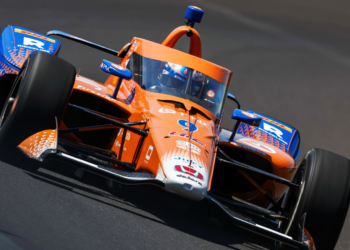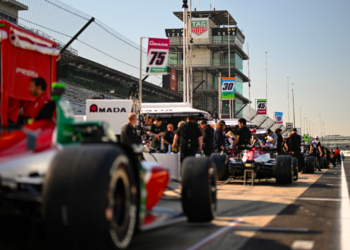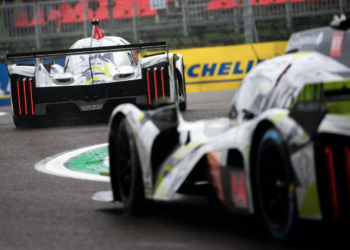There is more to Eddie Jordan than the eccentric TV presence of recent times. You may find this hard to believe, but almost exactly 20 years ago we had proof.
Then, as 1999’s summer gave way to autumn, the Jordan team ever so briefly looked like it could scale the ultimate peak of its driver becoming Formula 1 world champion. And with the odd card falling the other way he would have done. The driver in question was Heinz-Harald Frentzen.
Certainly across the last three decades or so in F1 a Frentzen and Jordan crown would have been beaten for unlikelihood only by Brawn’s triumphs in 2009. Yet in some ways the Jordan effort trumped even that. It didn’t have the peculiarity of a big technical rule change, nor of exploiting a grand loophole. Nor did Jordan design the car with vast manufacturer cash. This was a true independent team with a customer engine.
And one that, cynics suggested at 1999’s outset, was a ‘party team’ good at not delivering on its blarney. It had broken its victory duck the previous year, but that – the cynics further maintained – was in the most crazy and attritional of wet races at Spa. But in 1999 it oh-so nearly toppled Ferrari, McLaren-Mercedes and everyone else.
This was despite too that for the first time Jordan had to design, build, run and develop a F1 car without the technical leadership of Gary Anderson, as he’d left midway through the previous year. But it may have proved a boon, as Anderson possibly was still trying to do too much himself as the team grew. And even better there was a highly-talented group of underlings capable of stepping forward collectively into his vacated space.
They were led by Jordan’s highly-rated new technical chief Mike Gascoyne. And included Mark Smith, who went on to be Red Bull, Force India, Sauber and Caterham’s technical director.
There also was Sam Michael, later Williams’ technical director and McLaren’s sporting director; John Iley, also head of aero at McLaren, Ferrari and Renault as well as Caterham’s technical director; Dr John Davis, who went onto to be in charge of Williams’ aero facilities; and designer John McQuillam.
Little wonder the Jordan 199 was a fine car.
Across the last three decades or so in F1 a Frentzen and Jordan crown would have been beaten for unlikelihood only by Brawn’s triumphs in 2009. Yet in some ways the Jordan effort trumped even that
And in the driving seat there was a good old-fashioned redemption story. Frentzen once had an enviable up-and-comer reputation (even allowing that the trope about him out-pacing Michael Schumacher when Mercedes sportscar team-mates was a myth), but the two preceding years in Williams’ harsh environment had done little to extract his talent, and left him as damaged goods.
Yet he found downbeat Jordan much more agreeable, and developed a strong bond with his engineer Sam Michael. Frentzen started to make good on his promise. “Heinz had fresh motivation because he’d been removed from a top team. He was out to prove himself,” Michael observed.
It was in effect a team of one too, as Frentzen’s team-mate Damon Hill hardly performed, and was conspicuously counting his days to retirement from mid-year.
But driver number one and team proceeded impressively, displaying a combination of good pace, resolute consistency and smart strategic plays – aided by Frentzen being expert in fuel saving and tyre management. It even came together quintessentially to give them a win, in a wet-dry race at Magny-Cours in France, where Frentzen vaulted to first by stopping one time fewer than those around him – with Jordan employing the simple tactic of having a guy downwind with a mobile phone to inform it of what the weather was doing.
But even so for months the prospect of a Frentzen and Jordan title challenge was not on the agenda. Indeed it was so remote that when asked in the post-German Grand Prix press conference about his chances, Frentzen replied “my chances of what?”
Yet he was helped a lot by others faltering peculiarly. Michael Schumacher breaking his leg in a crash at Silverstone, ruling him out of the fight, changed the game. But it shouldn’t have changed it that much, as it left the way clear for McLaren’s reigning champion Mika Hakkinen to canter to the crown. He even was leading the table at the point of Schumacher’s injury.
Heinz had fresh motivation because he’d been removed from a top team. He was out to prove himself – Sam Michael
But Hakkinen then entered an extended run of his own misfortune. At Silverstone his wheel fell off; in Austria his team-mate David Coulthard spun him around on lap one; in Germany he first had a botched pitstop then his tyre exploded.
In Hungary Hakkinen at last won, and imperiously, but then he started to meet his bad luck halfway. In Belgium he put in what appeared a stroppy performance to second, with his nose put out of joint by Coulthard passing him at turn one, with an inadvertent bump on the way by. Then came Monza.
Hakkinen’s more immediate concern had been Schumacher’s Ferrari team-mate Eddie Irvine, who’d stepped into the Scuderia breach. He was only six points shy of Schumacher prior to Silverstone and second place there moved him level.
It got even better as two wins on the bounce got Irvine an eight-point championship lead over Hakkinen after Germany. But even that was not all that it seemed. After Schumacher’s accident Ferrari had switched focus to the following year’s car. Irvine was on top by default.
“I made mistakes, Mika made mistakes, my team made mistakes, McLaren made mistakes,” Irvine admitted. “We didn’t have the car quick enough. Mika definitely had the faster package. I had a more reliable package and I was making less mistakes than he was. But it was the hare trying to beat the tortoise.”
For months the prospect of a Frentzen title challenge was not on the agenda. When asked in the post-German Grand Prix press conference about his chances, Frentzen replied “my chances of what?”
At Monza it looked as if we were getting what we’d been anticipating for weeks, that Hakkinen at last was going to take control of the title battle. He led from pole, with Frentzen a few seconds shy doing his best to keep him honest. But then Hakkinen dropped down a gear too many at the first chicane and slid out.
Frentzen won. Irvine, off the pace again, could only get a point for sixth. And it was a collective scales-falling from-the-eyes moment. All of a sudden everyone twigged to the potential of the most unlikely, and heart-warming, of championship wins. The table read Hakkinen 60; Irvine 60; Frentzen 50. Within one win of the top.
It might have been even closer too. At Imola, Frentzen lost four points spinning off when Irvine’s unstitched Ferrari engine dumped oil on the road; at Canada he lost six points when he crashed after a brake disc went late on. The team reckons two points for fifth were on in Spain, but a driveshaft bearing failed. Then again, if ifs and buts were candy and nuts…
Frentzen also now had momentum, unlike the two ahead of him was not treading on his own tail, and there was even a ‘special’ engine on the way for its supplier Mugen’s season-concluding home round in Japan.
And Frenzten then followed up his Monza win by taking pole at the following round, at the Nurburgring – in pure terms Jordan’s most convincing display of the year. It was the team’s season in microcosm: there was opportunism, but with pace combined. There also was smart strategy and calm heads even as rain intervened on Saturday and Sunday.
Frentzen won, and it was a collective scales-falling from-the-eyes moment. Everyone twigged to the potential of the most unlikely, and heart-warming, of championship wins
“It was a high-downforce circuit and people said we would struggle,” Gascoyne noted. “And yet the car was quick all weekend, we got it right in qualifying, took pole, made a good start, led the first 35 laps – which Jordan had never done before – called the pitstop and executed it perfectly to retain the lead.”
But. Jordan had a clever launch device, and team-mate Hill grinding to a halt out of the opening chicane at the start was a portent.
The driver had to remember to cancel the launch function by pressing a button within 10 seconds, or risk the engine cutting out. Hill had indeed forgotten to do so on lap one. Then Frentzen when exiting the pits from his first stop, unnecessarily, triggered the device…then also neglected to press the button. His day was done.
And had he won that day the table, with two rounds left, would have read Hakkinen 61; Irvine 60; Frentzen 60.
More ifs and buts? Not entirely. “If he’d won and carried that momentum into Malaysia, it would have been a different story,” Sam Michael insisted.
Eddie Jordan concurred. “Psychologically, it was a huge chasm to climb out of after Nurburgring. That race was his,” he said. And Gascoyne took a similar view. “Having thrown the ‘Ring away, it affected him [Frentzen] greatly.”
In the next round, F1’s first visit to Sepang in Malaysia, he qualified only 14th, not helped by his headrest coming loose in qualifying, pitching him into a spin, then struggling with his left-front brake on the spare car. Come the race though he charged to sixth, setting second-fastest lap.
Qualifying and finishing fourth at Suzuka rounded off the year, leaving Frenzten a tantalising 22 points shy of the summit, and driver and team third in their respective tables.
If he’d won and carried that momentum into Malaysia, it would have been a different story – Sam Michael
And for neither did it get so good again. “That year he was fantastic, he just drove the car and didn’t try to design it,” Gascoyne recalled of Frentzen in ‘99. “Interestingly, in Australia 2000, he came up and said, ‘I want to have more input in the aero, I want to do this, I want to do that.’ To me, he lost focus and went back into his old ways. But in ‘99, he just drove the car.”
Jordan’s Mugen got long in the tooth in 2000; reliability more generally was poor. Jordan averaged only a point per race and slipped to sixth in the constructors’ table, behind even pariah BAR. Worse, in mid-2000 Gascoyne left for Renault, rather under a cloud, and took several technical staff with him.
The world economy was on a downslope plus manufacturers increased their presence in F1, and costs escalated. It all heralded Jordan’s downward spiral and Frentzen was sacked by the team in mid-2001.
“They’re great memories, but it’s also very sad,” said Eddie Jordan, summing up when his team, and F1, briefly partied like it’s 1999.






